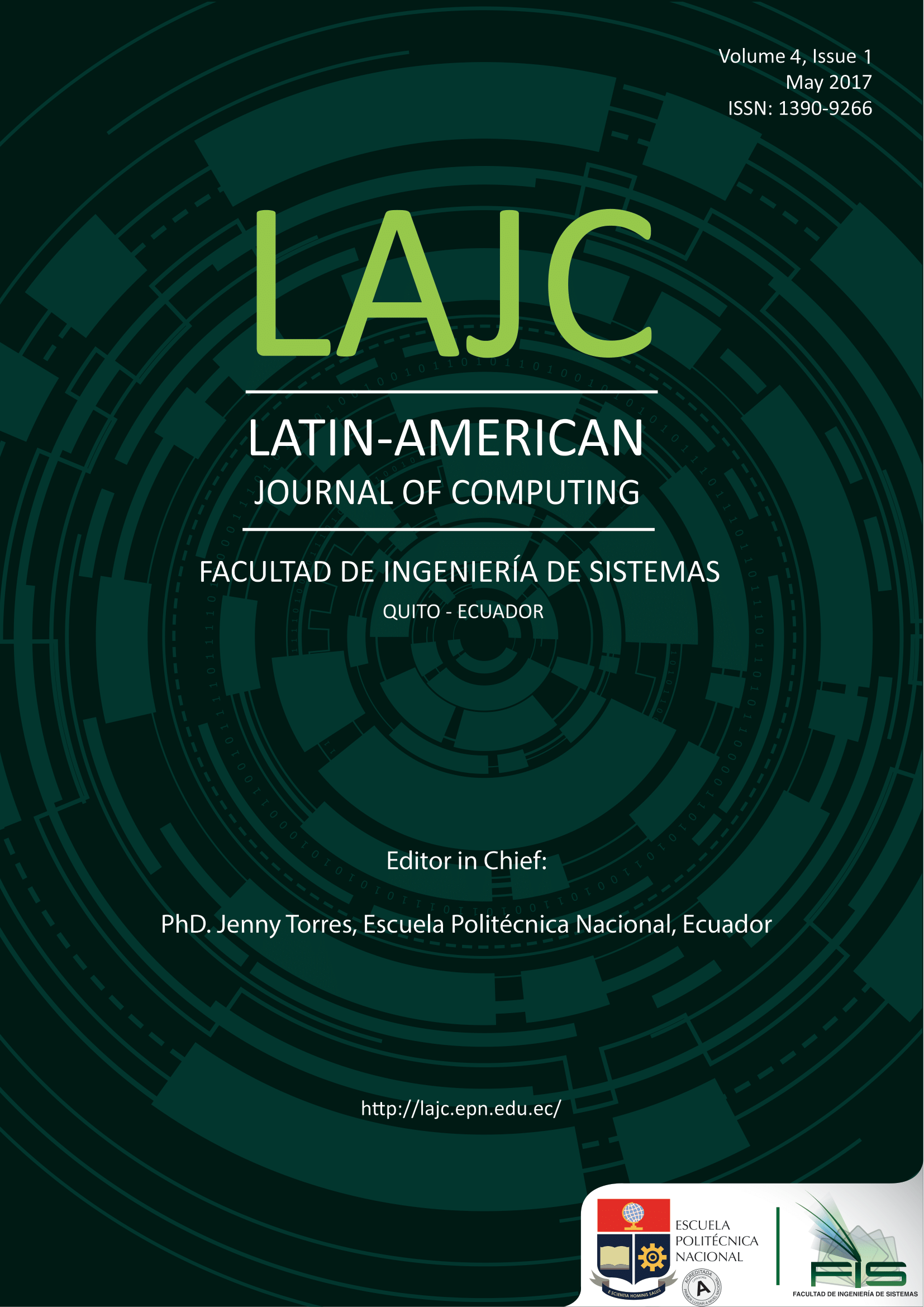Optimización con Colonia de Hormigas para la Planificación Óptima de la Fuerza de Trabajo
Palabras clave:
Workforce planning, metaheuristics, ant colony optimizationResumen
In this paper the problem of obtaining the Optimal Workforce Planning for enterprises is addressed as a mathematical optimization problem. Given the complexity and specific features of the corresponding optimization model, the Ant Colony Optimization metaheuristic was applied as the solution method. From computational experiments, we have shown the effectiveness of our proposal versus other state-of-art algorithms.
Descargas
Referencias
P. De Bruecker, J. Van den Bergh, J. Beliën, and E. Demeulemeester, “Workforce planning incorporating skills: State of the art,” Eur. J. Oper. Res., vol. 243, no. 1, pp. 1–16, 2015.
J. Wang, “A review ofoperations research applications in workforce planning and potential modelling of military training,” DSTO, 2005.
E. D. Philippe De Bruecker, Jorne Van den Bergh, Jeroen Beliën, “Workforce planning incorporating kills: State of the art,” Eur. J. Oper.Res., vol. 243, no. 1, pp. 1–16, 2015.
I. Boussaïd, J. Lepagnot, and P. Siarry, “A survey on optimization metaheuristics,” Inf. Sci. (Ny)., vol. 237, pp. 82–117, 2013.
E. Alba, G. Luque, and F. Luna, “Parallel metaheuristics for workforce planning,” J. Math. Model. Algorithms, vol. 6, no. 3, pp. 509–528, 2007.
K. M. Iman Fozveh, Hooman Salehi, “Presentation of Multi-Skill Workforce Scheduling Model and Solving the Model Using Meta-Heuristic Algorithms,” Mod. Appl. Sci., vol. 2, no. 10, pp. 194–205, 2016.
E. M. G.-N. Diego Novoa, Camilo Olarte, David Barrera, “A GRASP-based approach to the multi activity combined timetabling and crew scheduling problem considering a heterogeneous workforce,” Int. J. Ind. Eng. Comput., vol. 7, no. 4, pp. 597–606, 2016.
M. Dorigo and T. Stützle, Ant colony optimization. MIT Press, 2004.
A. Puris, “Desarrollo de meta-heurísticas poblacionales para la solución de problemas complejos,” Universidad Central “Marta Abreu” de Las Villas, 2010.
A. Puris, R. Bello, and F. Herrera, “Analysis of the efficacy of a Two-Stage methodology for ant colony optimization: Case of study with TSP and QAP,” Expert Syst. Appl., vol. 37, no. 7, 2010.
T. Glover, F., Kochenberger, G., Laguna, M., Wubbena, “Selection and assignment of a skilled workforce to meet job requirements in a fixed planning period.,” in MAEB, 2004, pp. 636–641.
M. Dorigo, M. Birattari, and T. Stutzle, “Ant colony optimization,” IEEE Comput. Intell. Mag., vol. 1, no. 4, pp. 28–39, Nov. 2006.
A. Puris, R. Bello, Y. Martínez, and A. Nowe, Two-stage ant colony optimization for solving the traveling salesman problem, vol. 4528 LNCS, no. PART 2. 2007.
L. M. Gambardella and M. Dorigo, “HAS-SOP: Hybrid Ant System For The Sequential Ordering Problem.” 1997.
J. E. Bell and P. R. McMullen, “Ant colony optimization techniques for the vehicle routing problem,” Adv. Eng. Informatics, vol. 18, no. 1, pp. 41–48, 2004.
T. Stutzle and H. H. Hoos, “MAX-MIN Ant System,” Futur. Gener. Comput. Syst., vol. 16, no. 8, pp. 889–914, 2000.
A. Puris, R. Bello, and F. Herrera, “Analysis of the efficacy of a Two-Stage methodology for ant colony optimization: Case of study with TSP and QAP,” Expert Syst. Appl., vol. 37, no. 7, pp. 5443–5453, 2010.
R. Bello, A. Puris, A. Nowe, Y. Martinez, and M. M. Garcia, “Two step ant colony system to solve the feature selection problem,” in PROGRESS IN PATTERN RECOGNITION IMAGE ANALYSIS AND APPLICATIONS PROCEEDINGS, 2006, vol. 4225, pp. 588–596.
G. G. Brunk, “A test of the Friedman-Savage gambling model,” Q. J. Econ., vol. 96, no. 2, pp. 341–348, 1981.
S. García, D. Molina, M. Lozano, and F. Herrera, “A study on the use of non-parametric tests for analyzing the evolutionary algorithms’ behaviour: a case study on the CEC’2005 Special Session on Real Parameter Optimization,” J Heuristics, vol. 15, pp. 617–644, 2009.
P. Novoa-Hernández, C. C. Corona, and D. A. Pelta, “Self-adaptive, multipopulation differential evolution in dynamic environments,” Soft Comput., vol. 17, no. 10, pp. 1861–1881, Mar. 2013.
P. Novoa-Hernández, C. C. Corona, and D. A. Pelta, “Self-adaptation in dynamic environments -a survey and open issues,” Int. J. Bio-Inspired Comput., vol. 8, no. 1, pp. 1–13, 2016.
Descargas
Publicado
Número
Sección
Licencia
Aviso de derechos de autor/a
Los autores/as que publiquen en esta revista aceptan las siguientes condiciones:
- Los autores conservan los derechos de autor y ceden a la revista el derecho de la primera publicación, con el trabajo registrado con la Creative Commons Attribution-Non-Commercial-Share-Alike 4.0 International, que permite a terceros utilizar lo publicado siempre que mencionen la autoría del trabajo y a la primera publicación en esta revista.
- Los autores pueden realizar otros acuerdos contractuales independientes y adicionales para la distribución no exclusiva de la versión del artículo publicado en esta revista (p. ej., incluirlo en un repositorio institucional o publicarlo en un libro) siempre que indiquen claramente que el trabajo se publicó por primera vez en esta revista.
- Se permite y recomienda a los autores a compartir su trabajo en línea (por ejemplo: en repositorios institucionales o páginas web personales) antes y durante el proceso de envío del manuscrito, ya que puede conducir a intercambios productivos, a una mayor y más rápida citación del trabajo publicado.
Descargo de Responsabilidad
LAJC en ningún caso será responsable de cualquier reclamo directo, indirecto, incidental, punitivo o consecuente de infracción de derechos de autor relacionado con artículos que han sido presentados para evaluación o publicados en cualquier número de esta revista. Más Información en nuestro Aviso de Descargo de Responsabilidad.










